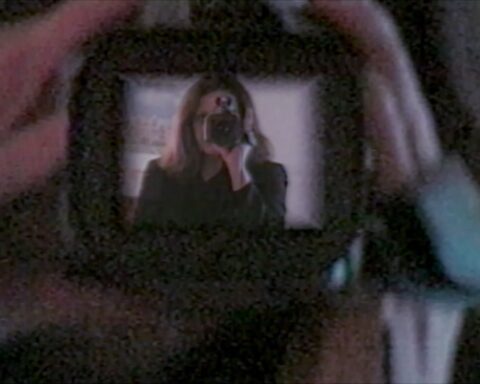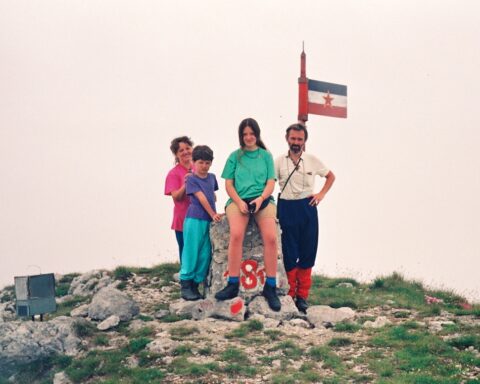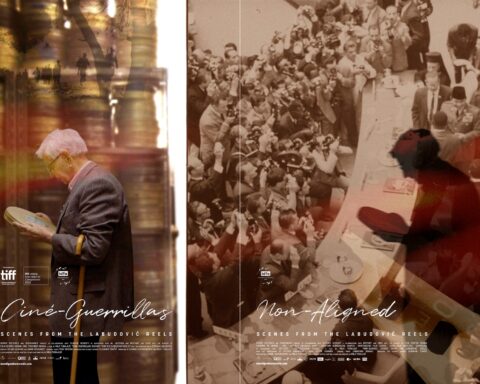IDFA’s DocLab is a festival programme for new media that showcases interactive ‘webdocs’ and other new forms of digital storytelling, stretching the documentary genre beyond linear filmmaking. As part of the Expanding Documentary Exhibition, 15 new media projects, including Katerina Cizek’s Highrise: One Millionth Tower and Toronto’s Pop Sandbox’s adolescent suicide work The Next Day, were on display at Amsterdam’s Brakke Grond art gallery.
Even for an open-minded organization like IDFA, web-based projects are hard to promote to cinephiles expecting docs on the big screen during a festival. Walking into the Brakke Grond to find 15 computer monitors certainly felt less cinematic than taking a seat in the plushy Pathé Tuschinski theatre in Amsterdam’s Rembrandtplein. Not to mention that all projects were available online at the DocLab website, which means you don’t need to visit an Amsterdam gallery to engage in the work.
But for DocLab founder and curator Caspar Sonnen, web projects are in need of exhibitions beyond the art world festival circuit, especially if they adhere to documenting life. And thus DocLab was born back in 2007 as a platform for documentary innovation, and since then it has annually invited an international jury to nominate and award the best examples of digital documentary storytelling.
During IDFA, nine of the web-docs in competition for the DocLab Award for Digital Storytelling were screened in cinemas for what was called ‘Live Cinema Events.’ The live portion evolved from the initial question that Caspar Sonnen had proposed to the DocLab programme: how do you turn something that is interactive into something linear, which can be watched by a group?
“Apart from the individual experience of someone navigating it themselves behind a computer, we wanted to create a communal experience, a festival experience,” said Sonnen. During the live events, the author of the work navigated the audience through his or her project, which means that each presentation was a singular interplay that could never be repeated. Whereas some projects became more performative on the big screen, others behaved more as a slideshow of image and sound.
“I really try not to present the DocLab programme as the future of documentary cinema,” explained Sonnen. “It’s just another form. Documentary cinema didn’t make documentary photography obsolete. Photography didn’t make painting obsolete. It’s simply a new means to tell a story.”
Digital Docs—The Winner
The winner of the IDFA DocLab Award for Digital Storytelling 2011 was Insitu, by French filmmaker Antoine Viviani. Presented both linearly and nonlinearly, the work connects city planners, architects, philosophers and artists in search of creative and artistic ways to intervene in public spaces. A meditation on the increasing urbanization of Europe, Insitu is told in individual chapters. As stated on the IDFA website, it includes “an architect with Noyo Voyages constantly working on improving the traffic circulation at a Parisian business park…an educational philosopher analyzing the tensions between the architectural heritage and the urban future of modern-day Berlin…and the whispered poems of Les Souffleurs encouraging street workers to dream of faraway palm beaches, while theremin player Pamelia Thurstin lets her sweet, weeping tones float through the city.”
As a 90-minute documentary or an interactive piece that allows you to choose the chapters separately through themes and a map of Europe, the Arte-produced Insitu is the first feature length work from Viviani, who has worked on music documentaries for R.E.M. and Arcade Fire with the French music filmmaker Vincent Moon. Viviani is also the founder of the production company Providences, based in Paris, through which he began to direct his own films.
With Insitu, Antoine Viviani “tried to invent a fantasized city, very abstract and sensorial, where strange things happen and we don’t know if what we are seeing is reality or fiction. This is really what fascinates me in cinema, the mental images, the emotions created by the link between images and sound, and how it can become ultimately a very powerful music.”
While artists and curators strive to find a home for interactive storytelling, Viviani said, “I don’t believe in the compartmentalization of genres; for me, the cinematographic elements at stake are always the same. I’m not saying new media or digital storytelling don’t have anything to invent, but I think we should just consider them as new tools, nothing more than new ways for imagining another relation between the image and the viewer. It doesn’t change for me the core of what cinema is about.”
Interactive Installations
While Antoine Viviani’s Insitu can screen as a film, other projects within the DocLab program functioned more as interactive installations, or in one instance, an online application.
A collaboration between France’s Arte and the National Film Board of Canada, Barcode.tv is being called a cinematic story machine, with 100 short films created by 30 filmmakers. Insert a word and a one-minute-long film pops up. The word should describe an object that you hold dear, as “objects are like mirrors.” The intention behind the collection of short films is to have our possessions look at us for a change, and show us who we are in the process.
If you type in ‘jeans’ you watch a young woman and man humorously struggle to pull up her extremely tight skinny jeans. Type in ‘coffee’ and you watch a film of a man soaking his breakfast, bed and desk with a watering can. Yet the film for ‘coffeemaker’ is simply an espresso maker overflowing on the stove. Try ‘computer’ and we go to a classroom where young children play with markers and coloured paper while talking about the creative and communicative possibilities that computers can offer. As the creators of Barcode.tv illustrate, “The associations are funny, surprising, mind-blowing, or simply absurd. They all make us think of our personal belongings in a new way, and with that also the image we thought we had of ourselves.”
Danfung Dennis, acclaimed photojournalist and director of the recently Oscar-nominated Afghanistan war documentary Hell and Back Again, created the iPad application Condition One, which turns his profession into a full-immersion, virtual-reality experience. Instead of capturing the world in flat photographic images, which can be frustrating and often limiting to cameramen in the field who wish to bring their experiences back to the other side of the world, the Condition One team uses a custom camera system that captures the entire human field of vision. The stories are then edited specifically for the tablet application to create a truly immersive experience. Each experience can be viewed as a stand-alone item or in a series of clips, accessed by theme or author.
Holding the iPad, the user is put at the centre of the action, whether it’s at a bloody conflict in pre-revolutionary Libya or during a chaotic police arrest on the streets of New Orleans. Tilting the tablet shifts the camera accordingly, allowing users to choose which area of the 360-degree image they want to look at.
The multimedia magazine project by TIME, Beyond 9/11, encompasses 40 men and women including former President George W. Bush, anchorman Tom Brokaw, General David Petraeus, along with Twin Tower survivors, artists, activists and several of the heroic first responders at Ground Zero, all of whom reflect on the attacks on the 10th anniversary of the September 11th attacks. Each person was interviewed separately, but all were asked the same question first: Where were you on that devastating day? The photographs and interviews were originally included in the commemorative anniversary issue of TIME, with the video portion compiled for an hour-long HBO documentary. Those same interviews can be viewed as a DocLab project by clicking on the individual black and white portraits, shot by photographer Marco Grob. But the degree to which these projects actually are cinematic might differ from person to person. “I would find a film cinematic if it gets me into another relationship with time, and how the length and depth of time can become a kind of music. For me, cinema is music,” explained Viviani.
Or is it the cinematography? “In this sense, Beyond 9/11 was certainly one of the most cinematic, using the beautiful and very classic black and white photographs and videos of Marco Grob,” continued Viviani. “Or on the contrary, is it something that is told by the relation between the images and the viewer? In this sense, Barcode.tv would certainly be the most cinematic one, because of the new relations it is inventing with the objects and the world around you.”
CAPE: Computer Automatic Personal Environment
What if you could physically walk through the past or maybe the future? What if you could walk in a reality that is ‘not here’? What if an artist could transform your reality and put you right in the middle of his artwork? During the Expanding Documentary Exhibition at IDFA, an interesting spectacle was taking place in the hallways of Amsterdam’s Brakke Grond gallery. Curious volunteers walked around with laptops on their backs, goggles over their eyes and monitors strapped to their fronts. Led blindly by a guide who escorted them around the gallery space, placed objects in their hands and cautiously moved them over and around obstacles, the participants were experiencing a new form of interactive cinema, going far beyond a few clicks on a computer screen to stand witness to a new world.
CAPE stands for Computer Automatic Personal Environment—a play on the acronym CAVE (Computer Automatic Virtual Environment). Developed by Brussels-based performance group CREW, which operates where art and science, performing arts and new technology intersect, CAPE is an immersive experience.
To simplify, a participant dons video goggles, headphones and a portable computer and becomes the protagonist through his own point of view by entering a previously shot filmic scene. Characters speak and reach out to him, helping him to experience his surroundings. On the external side (in reality), the guide watches the scene through the monitor attached to the participant’s chest and mimics the actions of the characters—taking his hand, leading him down a path, and so on.
CREW’s artistic director, Eric Joris, had been envisioning a situation in which people could travel alone with all the necessary gear to capture a situation, without a technical crew. They could move through landscapes and events and, in cinematic terms, slowly enter the ‘subject’ by meeting people, wandering around and absorbing what is interesting in immersive terms. The basic question being: can I experience it out of (or through) the body of someone or something else?
For Joris, CAPE was “a practical wish to have a system which can be used in a simple way, without the setting of a theatre. We can perform in unexpected sites now, for more people, without a whole technical team around it and without a central direction, meaning everybody is not seeing things at the same time,” says Joris. “The relative simplicity should also allow us to ask other artists toparticipate and make CAPE documentaries. And the artistic wish as a ‘maker’ to get away from fictional ‘constructed’ narratives, to explore and document immersive reality out there as it is.”
Joris has travelled to other treacherous lands and happenings with the CAPE gear, including Cairo during the Arab Spring and Japan shortly after the tsunami. “With CAPE I am turning to an approach with less performative action and much less live acts, or less theatre,” he explains. “But by going to places where reality—actuality—is at stake, like the tsunami or Tahrir Square, immersion makes a lot of sense. Documentaries often explain events and the structures behind them—they go to the rational. With an immersive tool… you can simulate an experience itself, however fragmented it may be…understood differently by the mind and the body.”
At its best, the view will be frameless. Immersion can take away the feeling of separation of the image and the viewer, “which is why a classic narrative of showing and telling makes no sense at all,” says Joris.
A very young art form
“Sometimes we tend to forget that cinema is still a very young art form, only one century old, so we shouldn’t be too focused on formats or standards,” said Antoine Viviani.
“For me, all these [web] projects tell stories about the world; that is their only value. They don’t tell stories about new media. And festivals like IDFA are just about that—documenting different stories and visions of the world.”
Likewise, Caspar Sonnen is not hung up on any criticism that web-docs are tarnishing the function and format of traditional documentary. “The negative responses usually come when new media becomes preachy, like the transmedia hype. It’s very risky to over-hype something very new and fragile.”
Adds Viviani, “For me, transmedia today doesn’t exist per se, these are just new tools to tell stories, or sometimes only concepts that are quite hard to really get a grip on.”
For DocLab, digital storytelling presents a plethora of opportunities, both challenging and just plain cool. “Storytelling is about manipulation, authorship and audience participation,” said Sonnen. “But the audience will never replace the author.”











